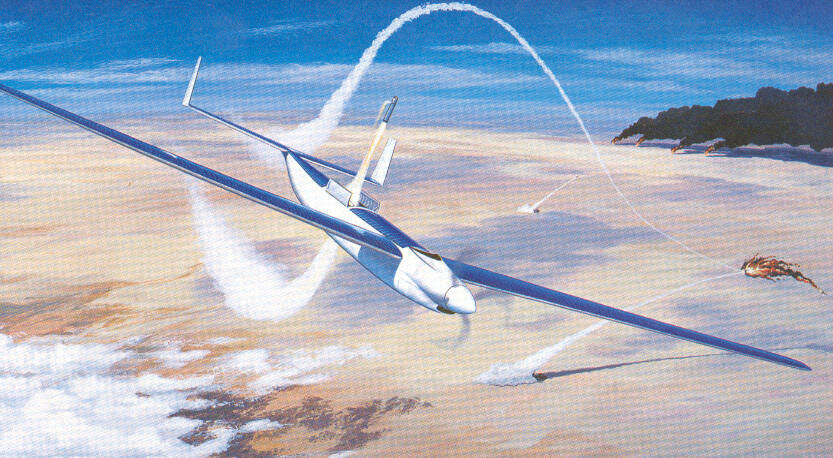- Joined
- 16 January 2015
- Messages
- 734
- Reaction score
- 2,829
Found on dtic.mil here, copy attached below.


Prime candidate:

Second candidate from Scaled Composites:

Talon interceptor:

To design, develop, and demonstrate the Responsive Aircraft Program for Theater Operations (RAPTOR), an unmanned aerial vehicle capable of sustained, high altitude, long-term flight, and to design, develop, and demonstrate the Theater Applications—Launch on Notice (TALON), a miniaturized kinetic kill interceptor for deployment aboard the RAPTOR. The RAPTOR/TALON system is a technology program, the concept of which is intended as a Boost Phase Interceptor capable of destroying tactical ballistic missiles during the first few minutes of flight.
The BMDO is proposing to design, develop, and demonstrate technologies supporting platforms and interceptors capable of meeting hostile theater ballistic missile threats.
Activities in support of the BMDO RAPTOR/TALON Program would occur iteratively.
Succeeding generations of launch platforms and interceptors would reflect technological advances as they are achieved during the program's progress. Major program activities would occur at several California locations: Lawrence Livermore National Laboratory (LLNL), Simi Valley, Mojave, the former George Air Force Base (AFB), Edwards AFB, and Norton AFB (slated for closure March 31, 1994). Activities would also occur at the Department of Energy's Nevada Test Site and at White Sands Missile Range, New Mexico.
Activities in support of the BMDO RAPTOR/TALON Program would fall into one or more of the following categories:
• Development and refinement of a solar electric test platform (SETP);
• Development of a follow-on generation SETP based on technologies and principles demonstrated with the first SETP;
• Development and demonstration of a conventional design fixed-wing gasoline engine-powered aircraft;
• Potential follow-on efforts directly resulting from technology advances in one or more of the preceding areas to produce ultimately a suitable platform;
• Potential development of an air-deliverable platform that would be based on the design concept of either the SETP, fixed-wing, or subsequent aircraft concepts;
• Design, development, and demonstration of a miniaturized lightweight kinetic kill interceptor missile using state-of-the-art sensors, guidance control, and miniaturized propulsion systems;
• Demonstration of an integrated platform and interceptor capable of intercepting theater ballistic missiles in their boost phase.
The prime SETP candidate would be a refurbished unmanned modular wing first developed by the Government for other purposes in the early 1980s. It would be refurbished for testing by AeroVironment, Inc., Simi Valley, California. Materials used in the battery-powered, eight-motor "wing" and future versions would be predominantly styrofoam, balsa, tape, and composites. A second candidate RAPTOR platform would be a more conventional design fixed-wing unmanned aerial vehicle. Scaled Composites, Inc., of Mojave, California, would manufacture the airframe. This platform would be powered by a turbocharged gasoline engine. It would be constructed primarily of composite materials. A substantial portion of the BMDO RAPTOR/TALON Program would be a research effort to design, develop, and demonstrate an efficient solar-powered energy
supply. To do so would require major advances in fuel cell technology.
The TALON would be a high endoatmospheric or exoatmospheric kinetic kill interceptor designed for launch from the RAPTOR platform. The TALON would attain a typical speed of 2 to 3 kilometers per second (approximately 4470 to 6700 miles per hour) and have an intercept range of approximately 100 kilometers (62 miles). The TALON interceptor would make use of a miniature pumped-propulsion system developed at
LLNL, Livermore, California, and would use hydrazine or hydrazine/nitrogen tetroxide as its propellant.


Prime candidate:

Second candidate from Scaled Composites:

Talon interceptor:




